Global Financial Crisis and Nepal's Economy
VerifiedAdded on 2020/06/05
|11
|3084
|122
AI Summary
This assignment examines the repercussions of the 2008 Global Financial Crisis on Nepal's economy. It delves into the impact on key sectors such as exports, foreign aid, and tourism, utilizing various sources including academic papers, reports, and online publications. The analysis explores how Nepal was affected by the global downturn and the subsequent economic adjustments made.
Contribute Materials
Your contribution can guide someone’s learning journey. Share your
documents today.
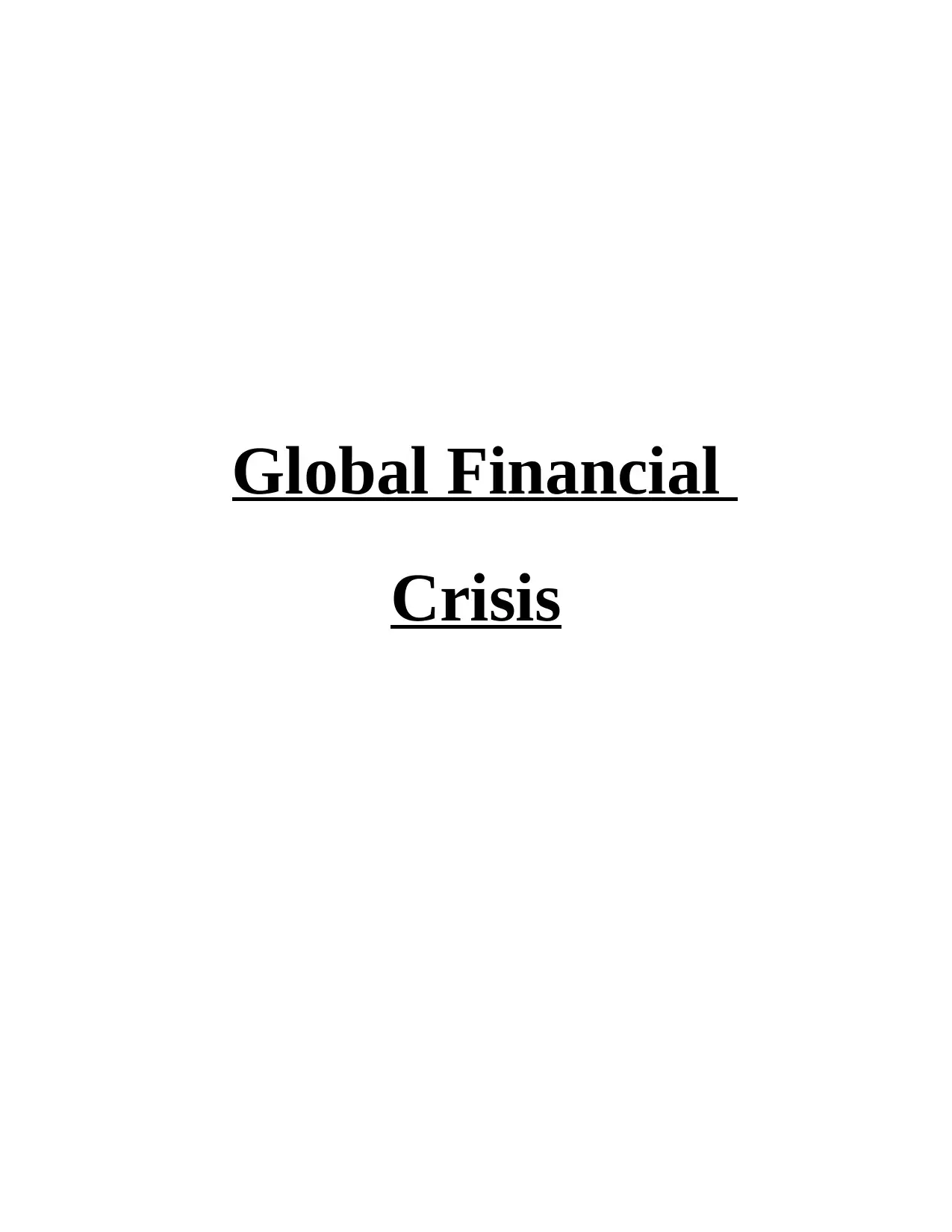
Global Financial
Crisis
Crisis
Secure Best Marks with AI Grader
Need help grading? Try our AI Grader for instant feedback on your assignments.
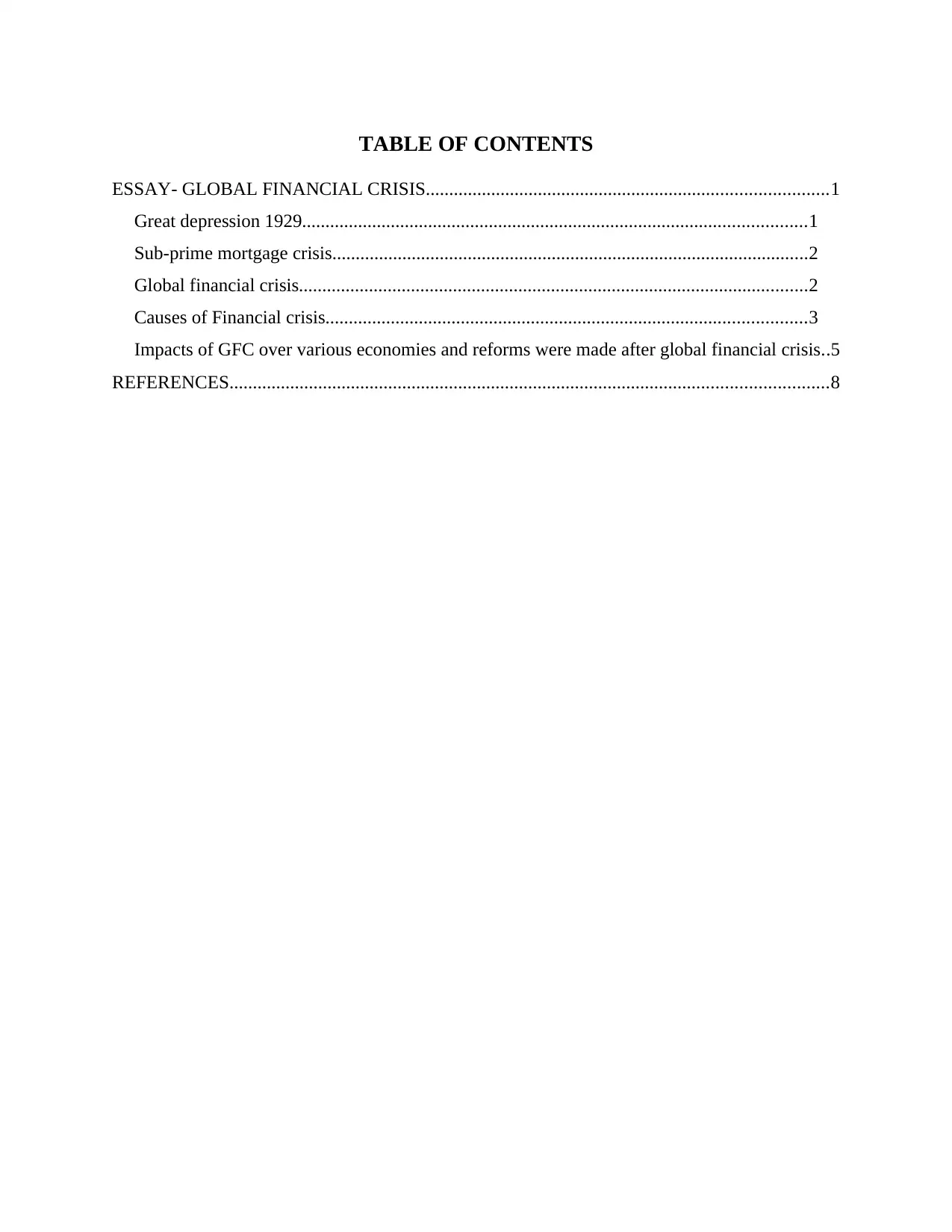
TABLE OF CONTENTS
ESSAY- GLOBAL FINANCIAL CRISIS......................................................................................1
Great depression 1929............................................................................................................1
Sub-prime mortgage crisis......................................................................................................2
Global financial crisis.............................................................................................................2
Causes of Financial crisis.......................................................................................................3
Impacts of GFC over various economies and reforms were made after global financial crisis..5
REFERENCES................................................................................................................................8
ESSAY- GLOBAL FINANCIAL CRISIS......................................................................................1
Great depression 1929............................................................................................................1
Sub-prime mortgage crisis......................................................................................................2
Global financial crisis.............................................................................................................2
Causes of Financial crisis.......................................................................................................3
Impacts of GFC over various economies and reforms were made after global financial crisis..5
REFERENCES................................................................................................................................8
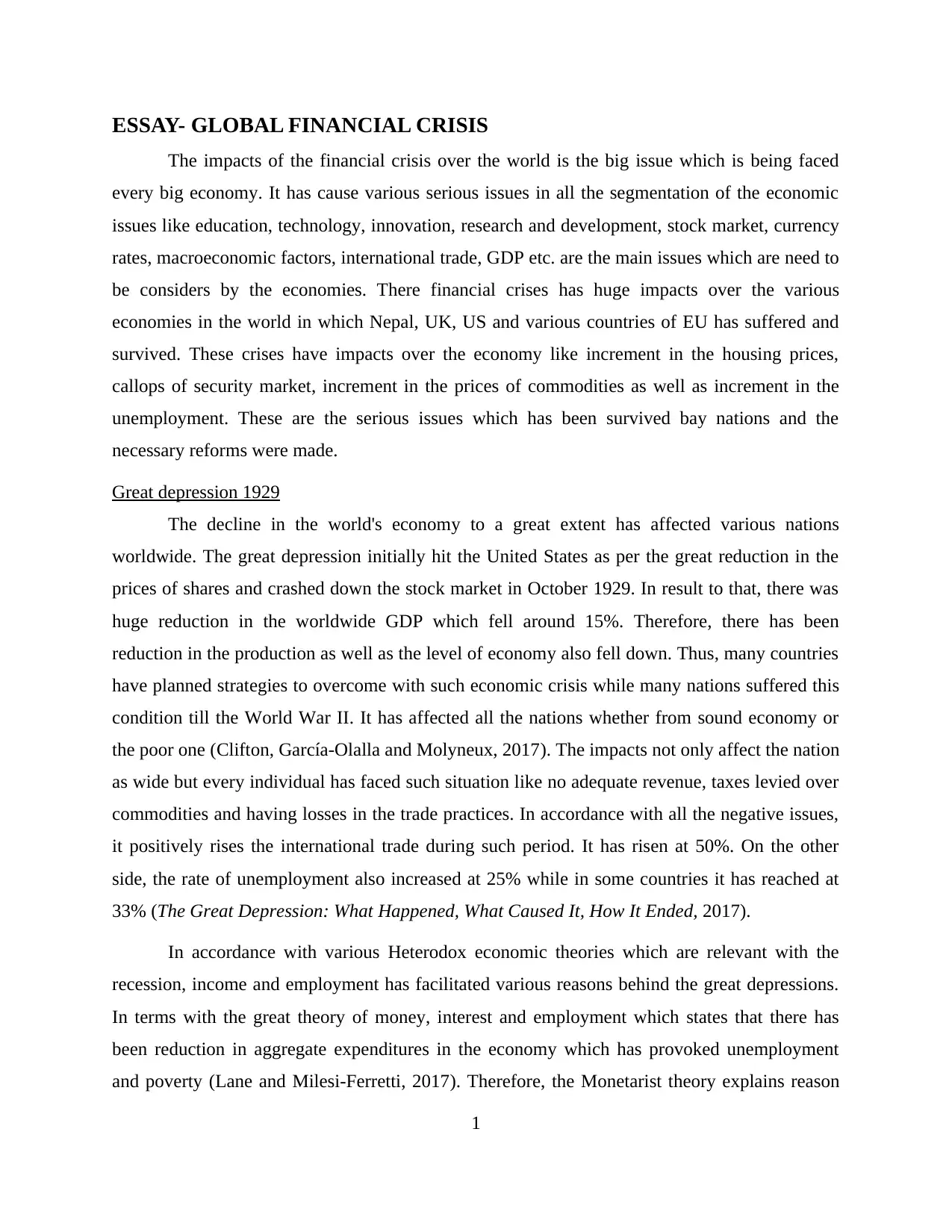
ESSAY- GLOBAL FINANCIAL CRISIS
The impacts of the financial crisis over the world is the big issue which is being faced
every big economy. It has cause various serious issues in all the segmentation of the economic
issues like education, technology, innovation, research and development, stock market, currency
rates, macroeconomic factors, international trade, GDP etc. are the main issues which are need to
be considers by the economies. There financial crises has huge impacts over the various
economies in the world in which Nepal, UK, US and various countries of EU has suffered and
survived. These crises have impacts over the economy like increment in the housing prices,
callops of security market, increment in the prices of commodities as well as increment in the
unemployment. These are the serious issues which has been survived bay nations and the
necessary reforms were made.
Great depression 1929
The decline in the world's economy to a great extent has affected various nations
worldwide. The great depression initially hit the United States as per the great reduction in the
prices of shares and crashed down the stock market in October 1929. In result to that, there was
huge reduction in the worldwide GDP which fell around 15%. Therefore, there has been
reduction in the production as well as the level of economy also fell down. Thus, many countries
have planned strategies to overcome with such economic crisis while many nations suffered this
condition till the World War II. It has affected all the nations whether from sound economy or
the poor one (Clifton, García-Olalla and Molyneux, 2017). The impacts not only affect the nation
as wide but every individual has faced such situation like no adequate revenue, taxes levied over
commodities and having losses in the trade practices. In accordance with all the negative issues,
it positively rises the international trade during such period. It has risen at 50%. On the other
side, the rate of unemployment also increased at 25% while in some countries it has reached at
33% (The Great Depression: What Happened, What Caused It, How It Ended, 2017).
In accordance with various Heterodox economic theories which are relevant with the
recession, income and employment has facilitated various reasons behind the great depressions.
In terms with the great theory of money, interest and employment which states that there has
been reduction in aggregate expenditures in the economy which has provoked unemployment
and poverty (Lane and Milesi-Ferretti, 2017). Therefore, the Monetarist theory explains reason
1
The impacts of the financial crisis over the world is the big issue which is being faced
every big economy. It has cause various serious issues in all the segmentation of the economic
issues like education, technology, innovation, research and development, stock market, currency
rates, macroeconomic factors, international trade, GDP etc. are the main issues which are need to
be considers by the economies. There financial crises has huge impacts over the various
economies in the world in which Nepal, UK, US and various countries of EU has suffered and
survived. These crises have impacts over the economy like increment in the housing prices,
callops of security market, increment in the prices of commodities as well as increment in the
unemployment. These are the serious issues which has been survived bay nations and the
necessary reforms were made.
Great depression 1929
The decline in the world's economy to a great extent has affected various nations
worldwide. The great depression initially hit the United States as per the great reduction in the
prices of shares and crashed down the stock market in October 1929. In result to that, there was
huge reduction in the worldwide GDP which fell around 15%. Therefore, there has been
reduction in the production as well as the level of economy also fell down. Thus, many countries
have planned strategies to overcome with such economic crisis while many nations suffered this
condition till the World War II. It has affected all the nations whether from sound economy or
the poor one (Clifton, García-Olalla and Molyneux, 2017). The impacts not only affect the nation
as wide but every individual has faced such situation like no adequate revenue, taxes levied over
commodities and having losses in the trade practices. In accordance with all the negative issues,
it positively rises the international trade during such period. It has risen at 50%. On the other
side, the rate of unemployment also increased at 25% while in some countries it has reached at
33% (The Great Depression: What Happened, What Caused It, How It Ended, 2017).
In accordance with various Heterodox economic theories which are relevant with the
recession, income and employment has facilitated various reasons behind the great depressions.
In terms with the great theory of money, interest and employment which states that there has
been reduction in aggregate expenditures in the economy which has provoked unemployment
and poverty (Lane and Milesi-Ferretti, 2017). Therefore, the Monetarist theory explains reason
1
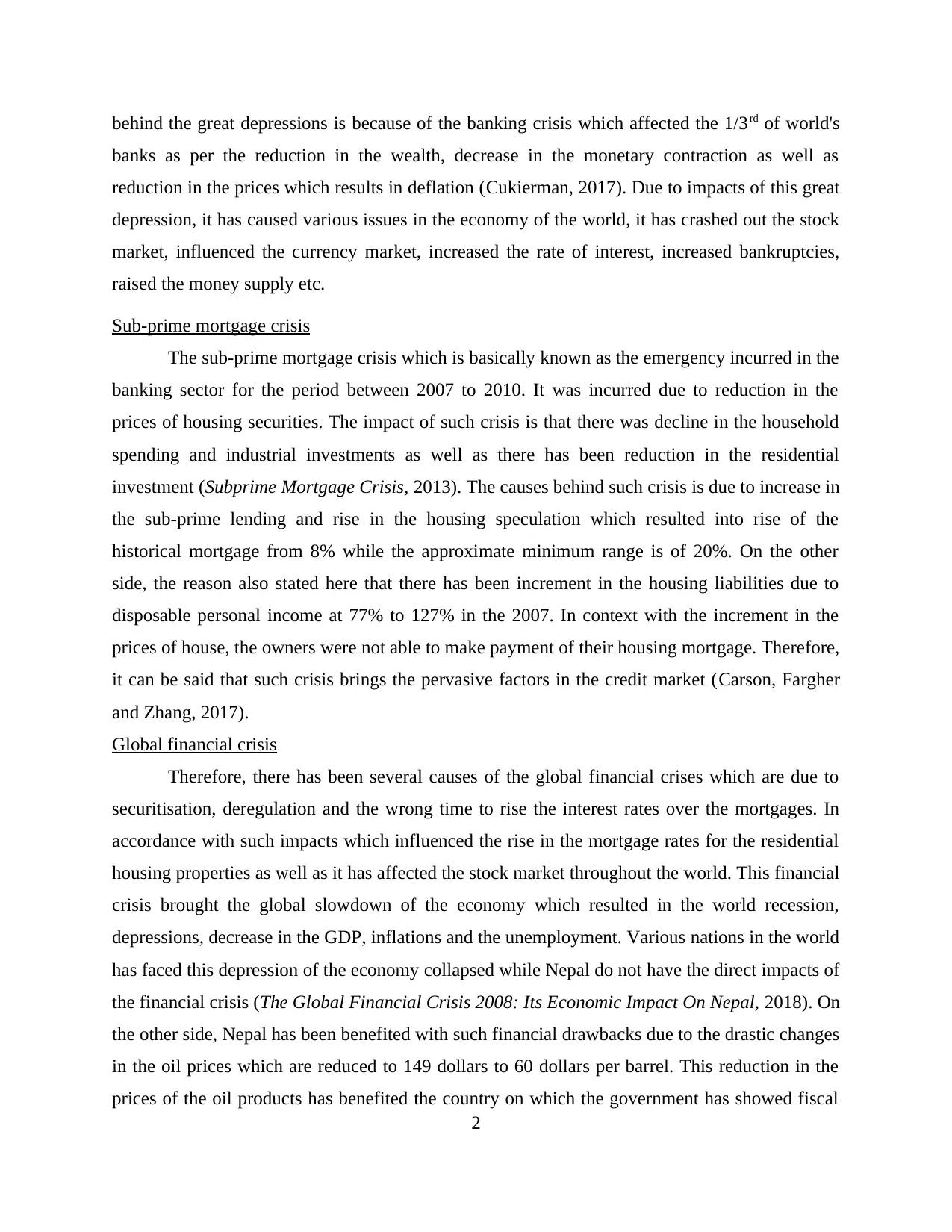
behind the great depressions is because of the banking crisis which affected the 1/3rd of world's
banks as per the reduction in the wealth, decrease in the monetary contraction as well as
reduction in the prices which results in deflation (Cukierman, 2017). Due to impacts of this great
depression, it has caused various issues in the economy of the world, it has crashed out the stock
market, influenced the currency market, increased the rate of interest, increased bankruptcies,
raised the money supply etc.
Sub-prime mortgage crisis
The sub-prime mortgage crisis which is basically known as the emergency incurred in the
banking sector for the period between 2007 to 2010. It was incurred due to reduction in the
prices of housing securities. The impact of such crisis is that there was decline in the household
spending and industrial investments as well as there has been reduction in the residential
investment (Subprime Mortgage Crisis, 2013). The causes behind such crisis is due to increase in
the sub-prime lending and rise in the housing speculation which resulted into rise of the
historical mortgage from 8% while the approximate minimum range is of 20%. On the other
side, the reason also stated here that there has been increment in the housing liabilities due to
disposable personal income at 77% to 127% in the 2007. In context with the increment in the
prices of house, the owners were not able to make payment of their housing mortgage. Therefore,
it can be said that such crisis brings the pervasive factors in the credit market (Carson, Fargher
and Zhang, 2017).
Global financial crisis
Therefore, there has been several causes of the global financial crises which are due to
securitisation, deregulation and the wrong time to rise the interest rates over the mortgages. In
accordance with such impacts which influenced the rise in the mortgage rates for the residential
housing properties as well as it has affected the stock market throughout the world. This financial
crisis brought the global slowdown of the economy which resulted in the world recession,
depressions, decrease in the GDP, inflations and the unemployment. Various nations in the world
has faced this depression of the economy collapsed while Nepal do not have the direct impacts of
the financial crisis (The Global Financial Crisis 2008: Its Economic Impact On Nepal, 2018). On
the other side, Nepal has been benefited with such financial drawbacks due to the drastic changes
in the oil prices which are reduced to 149 dollars to 60 dollars per barrel. This reduction in the
prices of the oil products has benefited the country on which the government has showed fiscal
2
banks as per the reduction in the wealth, decrease in the monetary contraction as well as
reduction in the prices which results in deflation (Cukierman, 2017). Due to impacts of this great
depression, it has caused various issues in the economy of the world, it has crashed out the stock
market, influenced the currency market, increased the rate of interest, increased bankruptcies,
raised the money supply etc.
Sub-prime mortgage crisis
The sub-prime mortgage crisis which is basically known as the emergency incurred in the
banking sector for the period between 2007 to 2010. It was incurred due to reduction in the
prices of housing securities. The impact of such crisis is that there was decline in the household
spending and industrial investments as well as there has been reduction in the residential
investment (Subprime Mortgage Crisis, 2013). The causes behind such crisis is due to increase in
the sub-prime lending and rise in the housing speculation which resulted into rise of the
historical mortgage from 8% while the approximate minimum range is of 20%. On the other
side, the reason also stated here that there has been increment in the housing liabilities due to
disposable personal income at 77% to 127% in the 2007. In context with the increment in the
prices of house, the owners were not able to make payment of their housing mortgage. Therefore,
it can be said that such crisis brings the pervasive factors in the credit market (Carson, Fargher
and Zhang, 2017).
Global financial crisis
Therefore, there has been several causes of the global financial crises which are due to
securitisation, deregulation and the wrong time to rise the interest rates over the mortgages. In
accordance with such impacts which influenced the rise in the mortgage rates for the residential
housing properties as well as it has affected the stock market throughout the world. This financial
crisis brought the global slowdown of the economy which resulted in the world recession,
depressions, decrease in the GDP, inflations and the unemployment. Various nations in the world
has faced this depression of the economy collapsed while Nepal do not have the direct impacts of
the financial crisis (The Global Financial Crisis 2008: Its Economic Impact On Nepal, 2018). On
the other side, Nepal has been benefited with such financial drawbacks due to the drastic changes
in the oil prices which are reduced to 149 dollars to 60 dollars per barrel. This reduction in the
prices of the oil products has benefited the country on which the government has showed fiscal
2
Paraphrase This Document
Need a fresh take? Get an instant paraphrase of this document with our AI Paraphraser
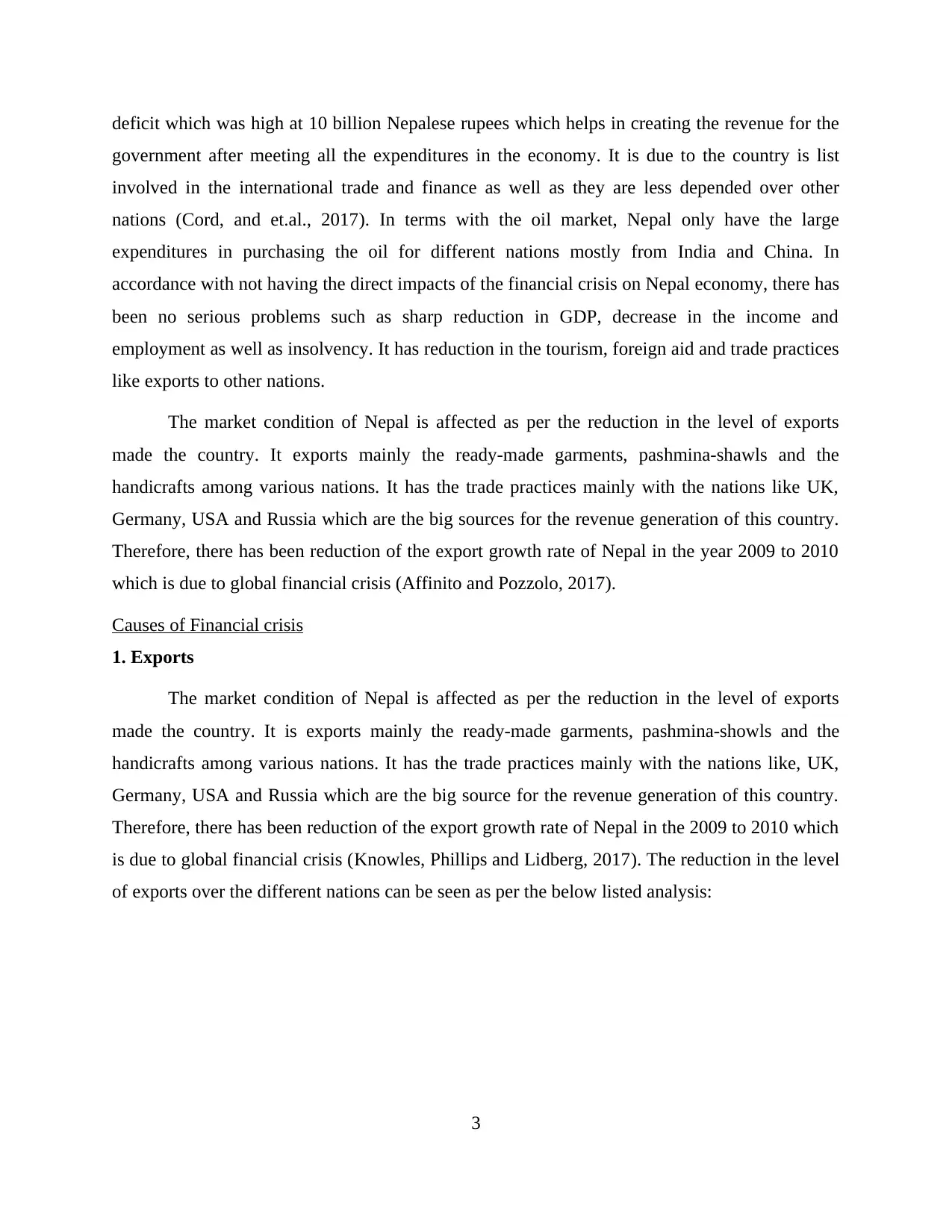
deficit which was high at 10 billion Nepalese rupees which helps in creating the revenue for the
government after meeting all the expenditures in the economy. It is due to the country is list
involved in the international trade and finance as well as they are less depended over other
nations (Cord, and et.al., 2017). In terms with the oil market, Nepal only have the large
expenditures in purchasing the oil for different nations mostly from India and China. In
accordance with not having the direct impacts of the financial crisis on Nepal economy, there has
been no serious problems such as sharp reduction in GDP, decrease in the income and
employment as well as insolvency. It has reduction in the tourism, foreign aid and trade practices
like exports to other nations.
The market condition of Nepal is affected as per the reduction in the level of exports
made the country. It exports mainly the ready-made garments, pashmina-shawls and the
handicrafts among various nations. It has the trade practices mainly with the nations like UK,
Germany, USA and Russia which are the big sources for the revenue generation of this country.
Therefore, there has been reduction of the export growth rate of Nepal in the year 2009 to 2010
which is due to global financial crisis (Affinito and Pozzolo, 2017).
Causes of Financial crisis
1. Exports
The market condition of Nepal is affected as per the reduction in the level of exports
made the country. It is exports mainly the ready-made garments, pashmina-showls and the
handicrafts among various nations. It has the trade practices mainly with the nations like, UK,
Germany, USA and Russia which are the big source for the revenue generation of this country.
Therefore, there has been reduction of the export growth rate of Nepal in the 2009 to 2010 which
is due to global financial crisis (Knowles, Phillips and Lidberg, 2017). The reduction in the level
of exports over the different nations can be seen as per the below listed analysis:
3
government after meeting all the expenditures in the economy. It is due to the country is list
involved in the international trade and finance as well as they are less depended over other
nations (Cord, and et.al., 2017). In terms with the oil market, Nepal only have the large
expenditures in purchasing the oil for different nations mostly from India and China. In
accordance with not having the direct impacts of the financial crisis on Nepal economy, there has
been no serious problems such as sharp reduction in GDP, decrease in the income and
employment as well as insolvency. It has reduction in the tourism, foreign aid and trade practices
like exports to other nations.
The market condition of Nepal is affected as per the reduction in the level of exports
made the country. It exports mainly the ready-made garments, pashmina-shawls and the
handicrafts among various nations. It has the trade practices mainly with the nations like UK,
Germany, USA and Russia which are the big sources for the revenue generation of this country.
Therefore, there has been reduction of the export growth rate of Nepal in the year 2009 to 2010
which is due to global financial crisis (Affinito and Pozzolo, 2017).
Causes of Financial crisis
1. Exports
The market condition of Nepal is affected as per the reduction in the level of exports
made the country. It is exports mainly the ready-made garments, pashmina-showls and the
handicrafts among various nations. It has the trade practices mainly with the nations like, UK,
Germany, USA and Russia which are the big source for the revenue generation of this country.
Therefore, there has been reduction of the export growth rate of Nepal in the 2009 to 2010 which
is due to global financial crisis (Knowles, Phillips and Lidberg, 2017). The reduction in the level
of exports over the different nations can be seen as per the below listed analysis:
3
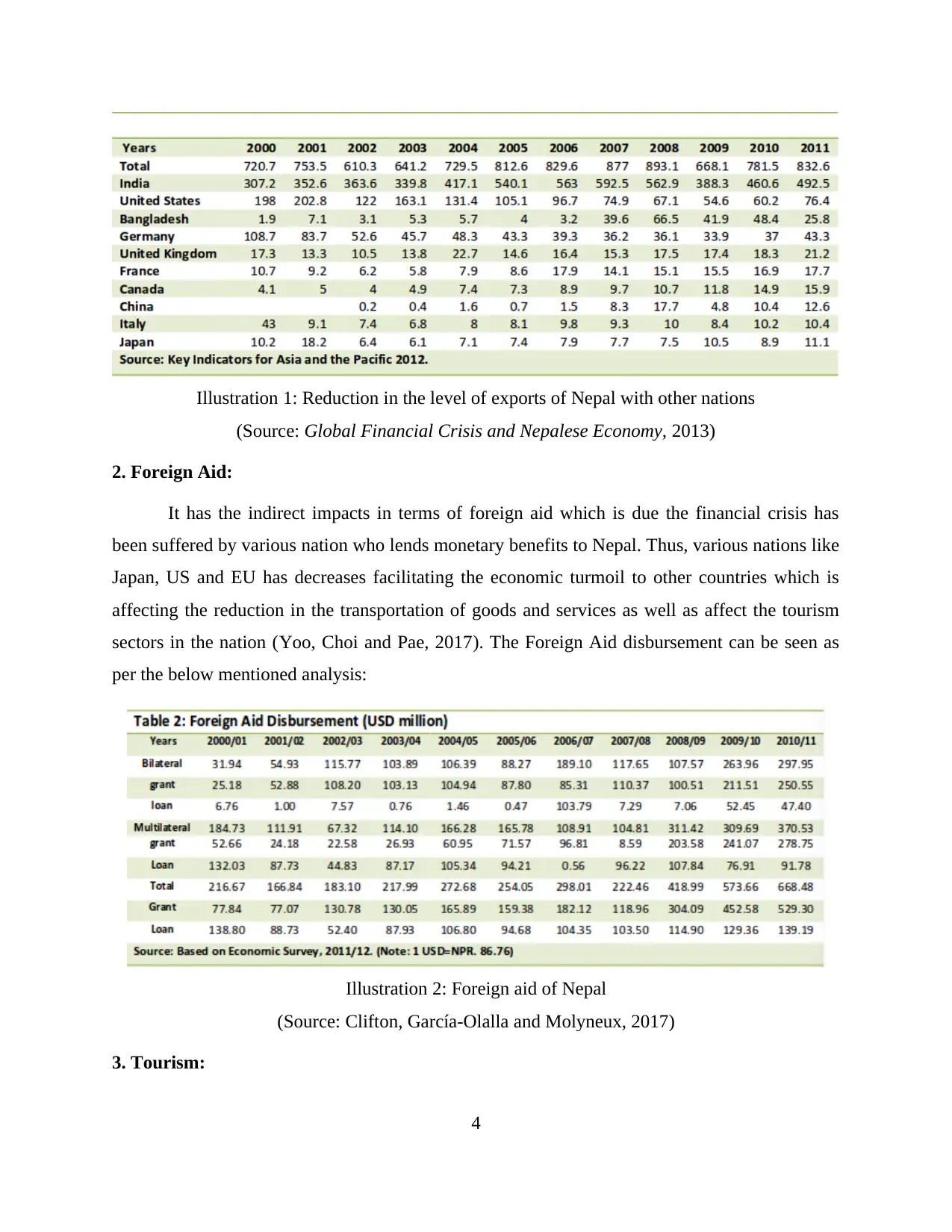
Illustration 1: Reduction in the level of exports of Nepal with other nations
(Source: Global Financial Crisis and Nepalese Economy, 2013)
2. Foreign Aid:
It has the indirect impacts in terms of foreign aid which is due the financial crisis has
been suffered by various nation who lends monetary benefits to Nepal. Thus, various nations like
Japan, US and EU has decreases facilitating the economic turmoil to other countries which is
affecting the reduction in the transportation of goods and services as well as affect the tourism
sectors in the nation (Yoo, Choi and Pae, 2017). The Foreign Aid disbursement can be seen as
per the below mentioned analysis:
Illustration 2: Foreign aid of Nepal
(Source: Clifton, García-Olalla and Molyneux, 2017)
3. Tourism:
4
(Source: Global Financial Crisis and Nepalese Economy, 2013)
2. Foreign Aid:
It has the indirect impacts in terms of foreign aid which is due the financial crisis has
been suffered by various nation who lends monetary benefits to Nepal. Thus, various nations like
Japan, US and EU has decreases facilitating the economic turmoil to other countries which is
affecting the reduction in the transportation of goods and services as well as affect the tourism
sectors in the nation (Yoo, Choi and Pae, 2017). The Foreign Aid disbursement can be seen as
per the below mentioned analysis:
Illustration 2: Foreign aid of Nepal
(Source: Clifton, García-Olalla and Molyneux, 2017)
3. Tourism:
4

There has been negative impacts over the tourism sector of Nepal because the citizens in
the country has controlled the level of expenditures of over the other nations which are aimed at
making the adequate growth in the business. However, as per the reduction in the trade practices
such as exports the maximum numbers of visitors has been reduced. The increment in the prices
of oil and petroleum products as risen the travelling costs and it becomes bull in the prices of
transportation which will be affecting the budgets of tourists (Lane and Milesi-Ferretti, 2017).
Thus, in these regards there has been huge reduction in the numbers of visitors in Nepal as well
as the revenue generation of government due to tourism has also fallen down. However, the
reduction in the revenue generation by Nepalese government can be shown at the below listed
diagram such as:
Illustration 3: Earning through tourism of Nepal
(Source: Affinito and Pozzolo, 2017)
Impacts of GFC over various economies and reforms were made after global financial crisis
There are various nations which are being affected by the Global financial crisis. They
have the direct and indirect impacts of this financial crisis and the remedies and strategies made
by various nations in context with overcoming such obstacles. There are several nations and the
impacts of GFC over their economy as well as the necessary steps to be taken by government as
to have economic reforms are as follows:
GFC vs UK:
5
the country has controlled the level of expenditures of over the other nations which are aimed at
making the adequate growth in the business. However, as per the reduction in the trade practices
such as exports the maximum numbers of visitors has been reduced. The increment in the prices
of oil and petroleum products as risen the travelling costs and it becomes bull in the prices of
transportation which will be affecting the budgets of tourists (Lane and Milesi-Ferretti, 2017).
Thus, in these regards there has been huge reduction in the numbers of visitors in Nepal as well
as the revenue generation of government due to tourism has also fallen down. However, the
reduction in the revenue generation by Nepalese government can be shown at the below listed
diagram such as:
Illustration 3: Earning through tourism of Nepal
(Source: Affinito and Pozzolo, 2017)
Impacts of GFC over various economies and reforms were made after global financial crisis
There are various nations which are being affected by the Global financial crisis. They
have the direct and indirect impacts of this financial crisis and the remedies and strategies made
by various nations in context with overcoming such obstacles. There are several nations and the
impacts of GFC over their economy as well as the necessary steps to be taken by government as
to have economic reforms are as follows:
GFC vs UK:
5
Secure Best Marks with AI Grader
Need help grading? Try our AI Grader for instant feedback on your assignments.
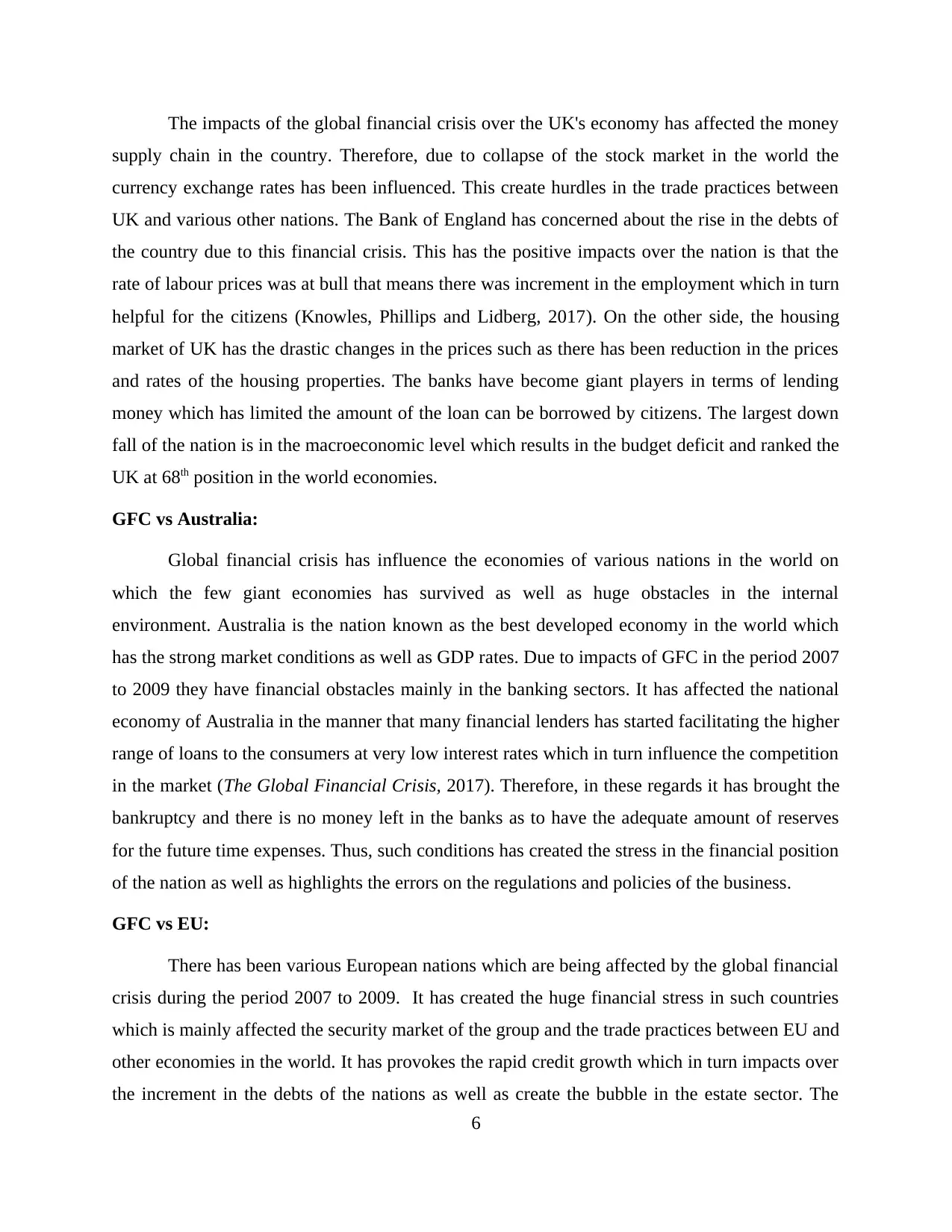
The impacts of the global financial crisis over the UK's economy has affected the money
supply chain in the country. Therefore, due to collapse of the stock market in the world the
currency exchange rates has been influenced. This create hurdles in the trade practices between
UK and various other nations. The Bank of England has concerned about the rise in the debts of
the country due to this financial crisis. This has the positive impacts over the nation is that the
rate of labour prices was at bull that means there was increment in the employment which in turn
helpful for the citizens (Knowles, Phillips and Lidberg, 2017). On the other side, the housing
market of UK has the drastic changes in the prices such as there has been reduction in the prices
and rates of the housing properties. The banks have become giant players in terms of lending
money which has limited the amount of the loan can be borrowed by citizens. The largest down
fall of the nation is in the macroeconomic level which results in the budget deficit and ranked the
UK at 68th position in the world economies.
GFC vs Australia:
Global financial crisis has influence the economies of various nations in the world on
which the few giant economies has survived as well as huge obstacles in the internal
environment. Australia is the nation known as the best developed economy in the world which
has the strong market conditions as well as GDP rates. Due to impacts of GFC in the period 2007
to 2009 they have financial obstacles mainly in the banking sectors. It has affected the national
economy of Australia in the manner that many financial lenders has started facilitating the higher
range of loans to the consumers at very low interest rates which in turn influence the competition
in the market (The Global Financial Crisis, 2017). Therefore, in these regards it has brought the
bankruptcy and there is no money left in the banks as to have the adequate amount of reserves
for the future time expenses. Thus, such conditions has created the stress in the financial position
of the nation as well as highlights the errors on the regulations and policies of the business.
GFC vs EU:
There has been various European nations which are being affected by the global financial
crisis during the period 2007 to 2009. It has created the huge financial stress in such countries
which is mainly affected the security market of the group and the trade practices between EU and
other economies in the world. It has provokes the rapid credit growth which in turn impacts over
the increment in the debts of the nations as well as create the bubble in the estate sector. The
6
supply chain in the country. Therefore, due to collapse of the stock market in the world the
currency exchange rates has been influenced. This create hurdles in the trade practices between
UK and various other nations. The Bank of England has concerned about the rise in the debts of
the country due to this financial crisis. This has the positive impacts over the nation is that the
rate of labour prices was at bull that means there was increment in the employment which in turn
helpful for the citizens (Knowles, Phillips and Lidberg, 2017). On the other side, the housing
market of UK has the drastic changes in the prices such as there has been reduction in the prices
and rates of the housing properties. The banks have become giant players in terms of lending
money which has limited the amount of the loan can be borrowed by citizens. The largest down
fall of the nation is in the macroeconomic level which results in the budget deficit and ranked the
UK at 68th position in the world economies.
GFC vs Australia:
Global financial crisis has influence the economies of various nations in the world on
which the few giant economies has survived as well as huge obstacles in the internal
environment. Australia is the nation known as the best developed economy in the world which
has the strong market conditions as well as GDP rates. Due to impacts of GFC in the period 2007
to 2009 they have financial obstacles mainly in the banking sectors. It has affected the national
economy of Australia in the manner that many financial lenders has started facilitating the higher
range of loans to the consumers at very low interest rates which in turn influence the competition
in the market (The Global Financial Crisis, 2017). Therefore, in these regards it has brought the
bankruptcy and there is no money left in the banks as to have the adequate amount of reserves
for the future time expenses. Thus, such conditions has created the stress in the financial position
of the nation as well as highlights the errors on the regulations and policies of the business.
GFC vs EU:
There has been various European nations which are being affected by the global financial
crisis during the period 2007 to 2009. It has created the huge financial stress in such countries
which is mainly affected the security market of the group and the trade practices between EU and
other economies in the world. It has provokes the rapid credit growth which in turn impacts over
the increment in the debts of the nations as well as create the bubble in the estate sector. The
6
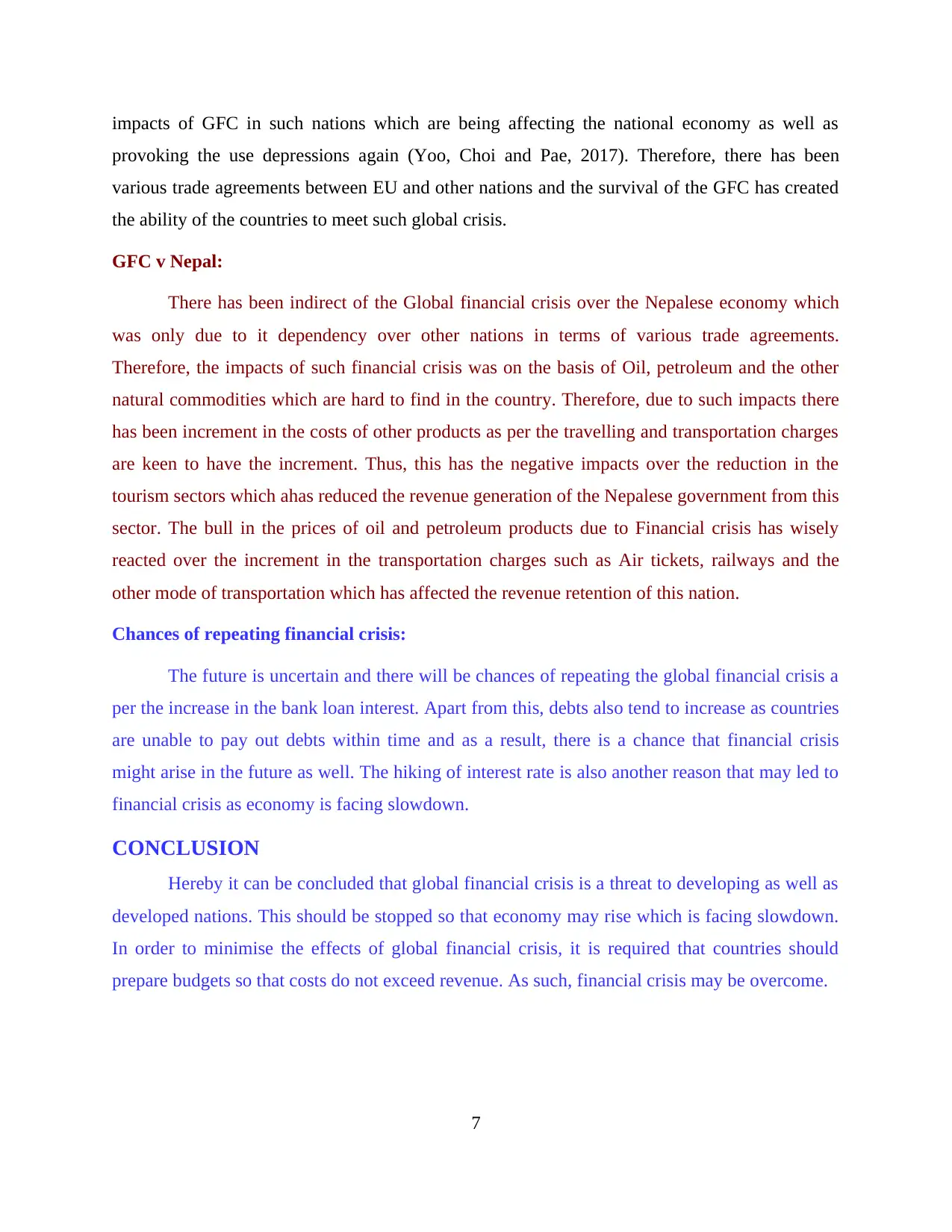
impacts of GFC in such nations which are being affecting the national economy as well as
provoking the use depressions again (Yoo, Choi and Pae, 2017). Therefore, there has been
various trade agreements between EU and other nations and the survival of the GFC has created
the ability of the countries to meet such global crisis.
GFC v Nepal:
There has been indirect of the Global financial crisis over the Nepalese economy which
was only due to it dependency over other nations in terms of various trade agreements.
Therefore, the impacts of such financial crisis was on the basis of Oil, petroleum and the other
natural commodities which are hard to find in the country. Therefore, due to such impacts there
has been increment in the costs of other products as per the travelling and transportation charges
are keen to have the increment. Thus, this has the negative impacts over the reduction in the
tourism sectors which ahas reduced the revenue generation of the Nepalese government from this
sector. The bull in the prices of oil and petroleum products due to Financial crisis has wisely
reacted over the increment in the transportation charges such as Air tickets, railways and the
other mode of transportation which has affected the revenue retention of this nation.
Chances of repeating financial crisis:
The future is uncertain and there will be chances of repeating the global financial crisis a
per the increase in the bank loan interest. Apart from this, debts also tend to increase as countries
are unable to pay out debts within time and as a result, there is a chance that financial crisis
might arise in the future as well. The hiking of interest rate is also another reason that may led to
financial crisis as economy is facing slowdown.
CONCLUSION
Hereby it can be concluded that global financial crisis is a threat to developing as well as
developed nations. This should be stopped so that economy may rise which is facing slowdown.
In order to minimise the effects of global financial crisis, it is required that countries should
prepare budgets so that costs do not exceed revenue. As such, financial crisis may be overcome.
7
provoking the use depressions again (Yoo, Choi and Pae, 2017). Therefore, there has been
various trade agreements between EU and other nations and the survival of the GFC has created
the ability of the countries to meet such global crisis.
GFC v Nepal:
There has been indirect of the Global financial crisis over the Nepalese economy which
was only due to it dependency over other nations in terms of various trade agreements.
Therefore, the impacts of such financial crisis was on the basis of Oil, petroleum and the other
natural commodities which are hard to find in the country. Therefore, due to such impacts there
has been increment in the costs of other products as per the travelling and transportation charges
are keen to have the increment. Thus, this has the negative impacts over the reduction in the
tourism sectors which ahas reduced the revenue generation of the Nepalese government from this
sector. The bull in the prices of oil and petroleum products due to Financial crisis has wisely
reacted over the increment in the transportation charges such as Air tickets, railways and the
other mode of transportation which has affected the revenue retention of this nation.
Chances of repeating financial crisis:
The future is uncertain and there will be chances of repeating the global financial crisis a
per the increase in the bank loan interest. Apart from this, debts also tend to increase as countries
are unable to pay out debts within time and as a result, there is a chance that financial crisis
might arise in the future as well. The hiking of interest rate is also another reason that may led to
financial crisis as economy is facing slowdown.
CONCLUSION
Hereby it can be concluded that global financial crisis is a threat to developing as well as
developed nations. This should be stopped so that economy may rise which is facing slowdown.
In order to minimise the effects of global financial crisis, it is required that countries should
prepare budgets so that costs do not exceed revenue. As such, financial crisis may be overcome.
7
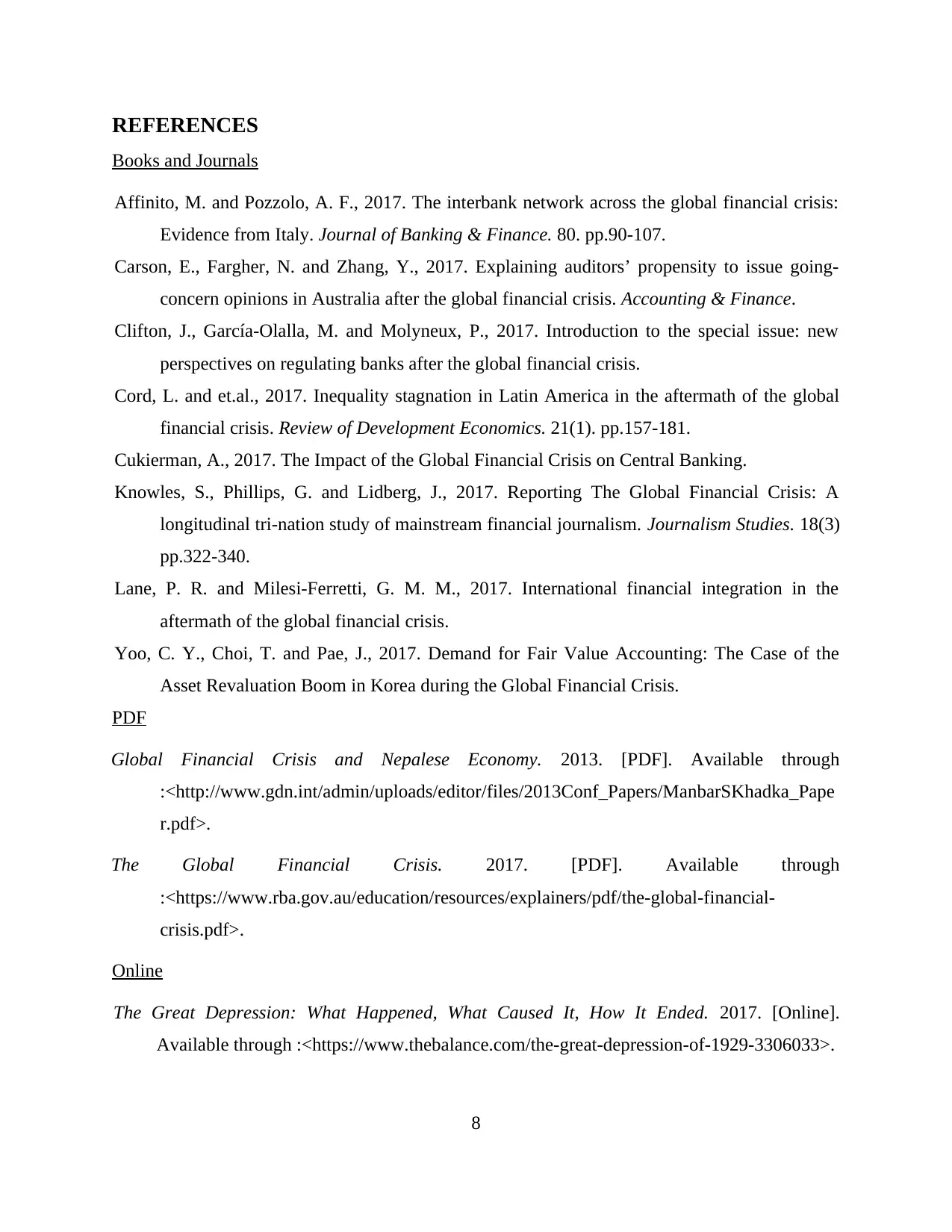
REFERENCES
Books and Journals
Affinito, M. and Pozzolo, A. F., 2017. The interbank network across the global financial crisis:
Evidence from Italy. Journal of Banking & Finance. 80. pp.90-107.
Carson, E., Fargher, N. and Zhang, Y., 2017. Explaining auditors’ propensity to issue going‐
concern opinions in Australia after the global financial crisis. Accounting & Finance.
Clifton, J., García-Olalla, M. and Molyneux, P., 2017. Introduction to the special issue: new
perspectives on regulating banks after the global financial crisis.
Cord, L. and et.al., 2017. Inequality stagnation in Latin America in the aftermath of the global
financial crisis. Review of Development Economics. 21(1). pp.157-181.
Cukierman, A., 2017. The Impact of the Global Financial Crisis on Central Banking.
Knowles, S., Phillips, G. and Lidberg, J., 2017. Reporting The Global Financial Crisis: A
longitudinal tri-nation study of mainstream financial journalism. Journalism Studies. 18(3)
pp.322-340.
Lane, P. R. and Milesi-Ferretti, G. M. M., 2017. International financial integration in the
aftermath of the global financial crisis.
Yoo, C. Y., Choi, T. and Pae, J., 2017. Demand for Fair Value Accounting: The Case of the
Asset Revaluation Boom in Korea during the Global Financial Crisis.
PDF
Global Financial Crisis and Nepalese Economy. 2013. [PDF]. Available through
:<http://www.gdn.int/admin/uploads/editor/files/2013Conf_Papers/ManbarSKhadka_Pape
r.pdf>.
The Global Financial Crisis. 2017. [PDF]. Available through
:<https://www.rba.gov.au/education/resources/explainers/pdf/the-global-financial-
crisis.pdf>.
Online
The Great Depression: What Happened, What Caused It, How It Ended. 2017. [Online].
Available through :<https://www.thebalance.com/the-great-depression-of-1929-3306033>.
8
Books and Journals
Affinito, M. and Pozzolo, A. F., 2017. The interbank network across the global financial crisis:
Evidence from Italy. Journal of Banking & Finance. 80. pp.90-107.
Carson, E., Fargher, N. and Zhang, Y., 2017. Explaining auditors’ propensity to issue going‐
concern opinions in Australia after the global financial crisis. Accounting & Finance.
Clifton, J., García-Olalla, M. and Molyneux, P., 2017. Introduction to the special issue: new
perspectives on regulating banks after the global financial crisis.
Cord, L. and et.al., 2017. Inequality stagnation in Latin America in the aftermath of the global
financial crisis. Review of Development Economics. 21(1). pp.157-181.
Cukierman, A., 2017. The Impact of the Global Financial Crisis on Central Banking.
Knowles, S., Phillips, G. and Lidberg, J., 2017. Reporting The Global Financial Crisis: A
longitudinal tri-nation study of mainstream financial journalism. Journalism Studies. 18(3)
pp.322-340.
Lane, P. R. and Milesi-Ferretti, G. M. M., 2017. International financial integration in the
aftermath of the global financial crisis.
Yoo, C. Y., Choi, T. and Pae, J., 2017. Demand for Fair Value Accounting: The Case of the
Asset Revaluation Boom in Korea during the Global Financial Crisis.
Global Financial Crisis and Nepalese Economy. 2013. [PDF]. Available through
:<http://www.gdn.int/admin/uploads/editor/files/2013Conf_Papers/ManbarSKhadka_Pape
r.pdf>.
The Global Financial Crisis. 2017. [PDF]. Available through
:<https://www.rba.gov.au/education/resources/explainers/pdf/the-global-financial-
crisis.pdf>.
Online
The Great Depression: What Happened, What Caused It, How It Ended. 2017. [Online].
Available through :<https://www.thebalance.com/the-great-depression-of-1929-3306033>.
8
Paraphrase This Document
Need a fresh take? Get an instant paraphrase of this document with our AI Paraphraser
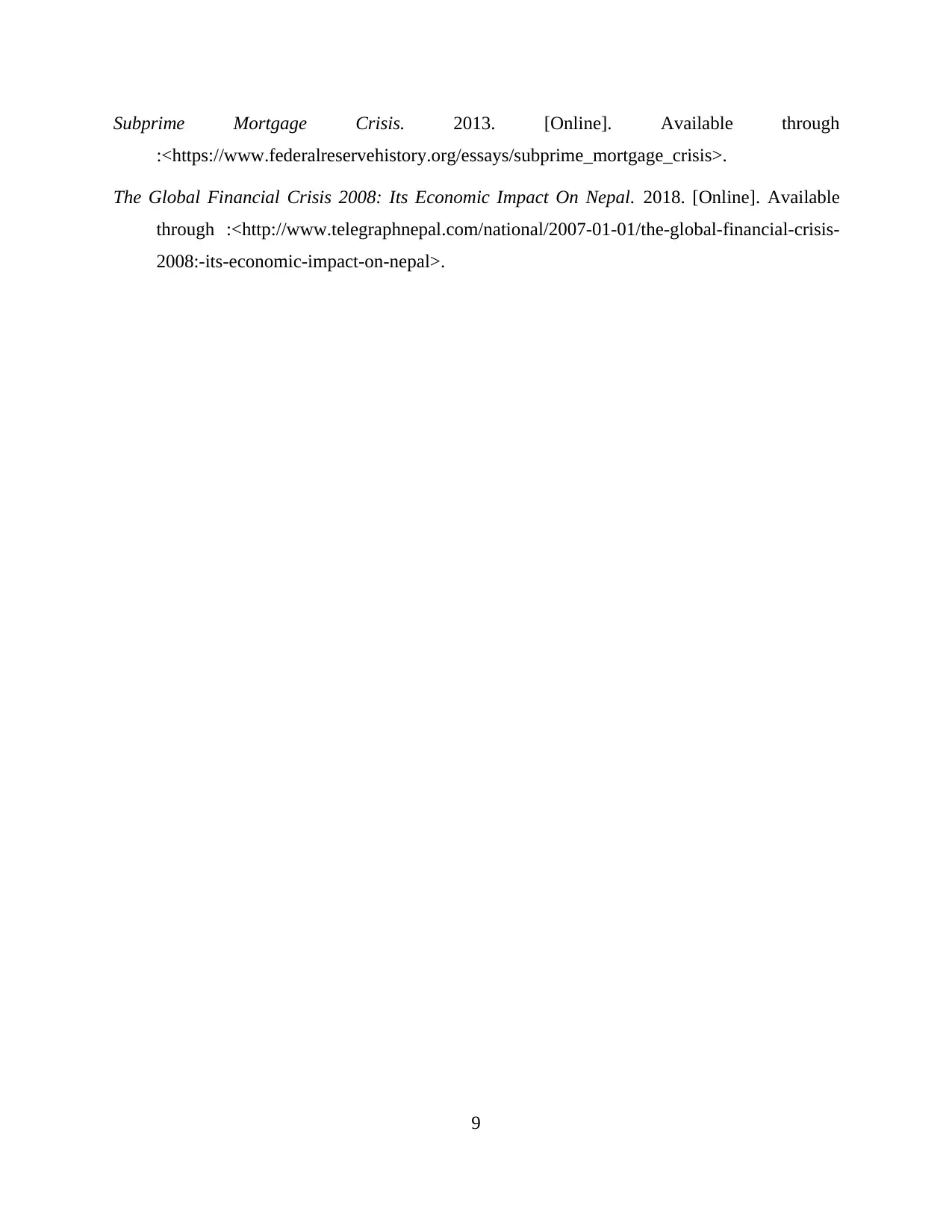
Subprime Mortgage Crisis. 2013. [Online]. Available through
:<https://www.federalreservehistory.org/essays/subprime_mortgage_crisis>.
The Global Financial Crisis 2008: Its Economic Impact On Nepal. 2018. [Online]. Available
through :<http://www.telegraphnepal.com/national/2007-01-01/the-global-financial-crisis-
2008:-its-economic-impact-on-nepal>.
9
:<https://www.federalreservehistory.org/essays/subprime_mortgage_crisis>.
The Global Financial Crisis 2008: Its Economic Impact On Nepal. 2018. [Online]. Available
through :<http://www.telegraphnepal.com/national/2007-01-01/the-global-financial-crisis-
2008:-its-economic-impact-on-nepal>.
9
1 out of 11
Related Documents
Your All-in-One AI-Powered Toolkit for Academic Success.
+13062052269
info@desklib.com
Available 24*7 on WhatsApp / Email
![[object Object]](/_next/static/media/star-bottom.7253800d.svg)
Unlock your academic potential
© 2024 | Zucol Services PVT LTD | All rights reserved.





